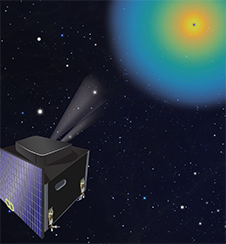 Launch Date: February 2025
Launch Date: February 2025
Phase B – Design & Technology Completion
The Global Lyman-alpha Imager of the Dynamic Exosphere (GLIDE) mission is a Solar Terrestrial Probes Science Mission of Opportunity expected to launch with the IMAP mission in 2025. GLIDE is being developed to acquire images of Earth's outermost atmospheric layer, known as the exosphere, which plays a key role in mediating Earth's response to geomagnetic storms, and it is the pathway for the slow but permanent escape of Earth's upper atmosphere into space. During its two-year mission, GLIDE will reveal the nature and physical drivers of global exospheric structure and temporal variability.
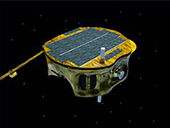 Launch Date: February 2025
Launch Date: February 2025
Phase C – Final Design & Fabrication
The Interstellar Mapping and Acceleration Probe (IMAP) science mission is being developed for launch in 2024 to help researchers better understand the boundary of the heliosphere, a sort of magnetic bubble surrounding and protecting our solar system. This region is where the constant flow of particles from our Sun, called the solar wind, collides with material from the rest of the galaxy. This collision limits the amount of harmful cosmic radiation entering the heliosphere. IMAP will collect and analyze particles that make it through.
Another objective of the mission is to learn more about the generation of cosmic rays in the heliosphere. Cosmic rays created locally and from the galaxy and beyond affect human explorers in space and can harm technological systems, and likely play a role in the presence of life itself in the universe.
Stated more formally, IMAP’s science objectives are to:
The spacecraft will be positioned about one million miles (1.5 million kilometers) away from Earth towards the Sun at what is called the first Lagrange point or L1. It is a spinning spacecraft that is about 8 feet in diameter and 3.5 feet tall (roughly 240 cm x 110 cm). The 10 science instruments on IMAP that will run continuously as it spins four times per minute.
Three of the instruments—IMAP-Lo, IMAP-Hi and IMAP-Ultra—will use energetic neutral atoms to detect particles from the invisible heliosphere and beyond. They have higher resolution and many times the collection power of the previous missions (on average, 15 times, 25 times and 35 times, respectively).
Five instruments—CoDICE, HIT, MAG, SWAPI and SWE—will measure different components of the solar wind and energetic particles that will allow the detailed understanding of particle acceleration, as well as providing real-time data about the space weather heading toward Earth.
The remaining two instruments, IDEX and GLOWS, will look at interstellar dust and ultraviolet radiation. Altogether, IMAP's 10 instruments will provide observations to address the four primary science objectives stated earlier.
The mission's principal investigator is David McComas of Princeton University. The Johns Hopkins University's Applied Physics Laboratory (JHU-APL) in Laurel, Maryland, will provide project management and will develop and integrate the spacecraft. The mission’s 10 science instruments are being provided by research organizations and universities, including JHU-APL, Southwest Research Institute, Los Alamos National Laboratory and GSFC.
 Launch Date: February 2025
Launch Date: February 2025
Phase B – Design & Technology Completion
Solar Cruiser is a pathfinder technology demonstration mission that will enable near-term missions to address important science questions about the Sun, its interaction with Earth, and other elements of the heliosphere. Solar Cruiser will demonstrate how solar sail propulsion can enable spacecraft to collect observations from novel vantage points that are difficult to reach and sustain. Specifically, Solar Cruiser will maintain a position sunward of Lagrange point L1—the position where Earth's and the Sun's gravity are balanced along the Sun-Earth-Line. Solar Cruiser will also demonstrate technologies that will enable future missions to improve space-weather monitoring, prediction, and science.
Solar sails use large, highly reflective, lightweight material that reflects sunlight to propel a spacecraft. The continuous photon pressure from the Sun's rays provides thrust with no need for the heavy, expendable propellants employed by conventional chemical and electric propulsion systems that limit mission lifetime and observation locations. Solar Cruiser will demonstrate the ability of solar sails to enable missions to observe the solar environment from unique vantage points of interest to Heliophysics science, including sustained station-keeping sunward of L1. Monitoring the Sun at this orbital location is of interest not only to NASA scientists, but also to support human spaceflight crew safety and health, the National Oceanic and Atmospheric Administration (NOAA), and the Department of Defense. Solar Cruiser will also demonstrate the capability to obtain sustained in-situ Earth magnetotail measurements and the ability to achieve and maintain a high-inclination solar orbit—a capability which future missions to image the polar regions of the Sun will require.
Solar Cruiser will fly a large, four-quadrant solar sail on a ten-month mission that demonstrates numerous technologies necessary to implement exciting, future missions to destinations heretofore unreachable. Solar Cruiser includes the largest sail ever flown—a 1653 m2, 2.5-micron thick reflective sail that is thinner than a human hair. Solar Cruiser also includes four 29.5-m, lightweight, composite booms to deploy the sail; embedded thin film photovoltaics to demonstrate a new method of power generation; and embedded Reflective Control Devices (RCDs) that will help keep the sail stable. Once it successfully demonstrates these technologies, solar sail propulsion using large, high-performance sails will be available for future science missions, providing a new capability for NASA and the Nation.
The mission's principal investigator is Les Johnson at NASA's Marshall Space Flight Center (MSFC). MSFC, in Huntsville, AL will provide project management and be responsible for mission design, development of the attitude determination and control system software, and mission operations. Ball Aerospace will provide the spacecraft bus and its integration. Roccor will provide the solar sail system and active mass translator (for helping to manage the sail's momentum during flight). NASA GSFC is providing a co-investigator. Student collaboration teams are at Purdue University and The University of Alabama.
Photo Description: The Solar Cruiser will demonstrate solar sail propulsion by flying sunward of L1 and maintaining its position along the Sun-Earth-Line using only reflected sunlight for propulsion.
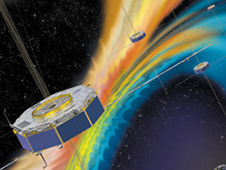 Launched March 12, 2015 at 10:44pm
Launched March 12, 2015 at 10:44pm
Phase – Operating
The Magnetospheric Multiscale (MMS) mission is a Solar Terrestrial Probes mission comprising four identically instrumented spacecraft that will use Earth’s magnetosphere as a laboratory to study the microphysics of three fundamental plasma processes: magnetic reconnection, energetic particle acceleration, and turbulence. These processes occur in all astrophysical plasma systems but can be studied in situ only in our solar system and most efficiently only in Earth’s magnetosphere, where they control the dynamics of the geospace environment and play an important role in the processes known as “space weather.”
+ Learn more about the MMS Mision
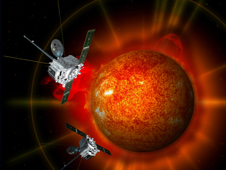 Launched October 25, 2006
Launched October 25, 2006
Phase – Operating
STEREO (Solar TErrestrial RElations Observatory) is the third mission in NASA’s Solar Terrestrial Probes program (STP). This two-year mission will provide a unique and revolutionary view of the Sun-Earth System. The two nearly identical observatories - one ahead of Earth in its orbit, the other trailing behind – will trace the flow of energy and matter from the Sun to Earth as well as reveal the 3D structure of coronal mass ejections and help us understand why they happen. STEREO will also provide alerts for Earth-directed solar ejections, from its unique side-viewing perspective adding it to the fleet of Space Weather detection satellites.
+ Learn more about the STEREO Mission
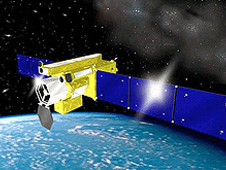 Launched September 23, 2006
Launched September 23, 2006
Phase – Operating
The Hinode (Solar-B) is a highly sophisticated observational satellite equipped with three advanced solar telescopes. It was launched on September 22, 2006. Its solar optical telescope (SOT) has an unprecedented 0.2 arcsec resolution for the observation of solar magnetic fields. It would resolve a feature with the size of 50cm, if it observed the Earth. The X-ray telescope (XRT) has a resolution of three times as high as Yohkoh, and the EUV imaging spectrometer (EIS) has sensitivity ten times as high as the ESA SOHO instrument. These X-ray and EUV telescopes would reveal the heating mechanism and dynamics of the active solar corona.
+ Learn more about the Hinode Mission
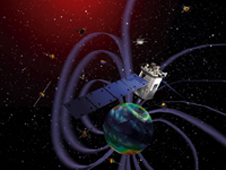 Launched December 7, 2001
Launched December 7, 2001
Phase – Operating
Thermosphere, Ionosphere, Mesosphere Energetics and Dynamics (TIMED) explores the Earth’s Mesosphere and Lower Thermosphere (60-180 kilometers up), the least explored and understood region of our atmosphere. It is known that the global structure of this region can be perturbed during stratospheric warmings and solar-terrestrial events, but the overall structure and dynamics responses of these effects are not understood. Advances in remote sensing technology employed by TIMED will enable us to explore this region on a global basis from space.
+ Learn more about the TIMED Mission